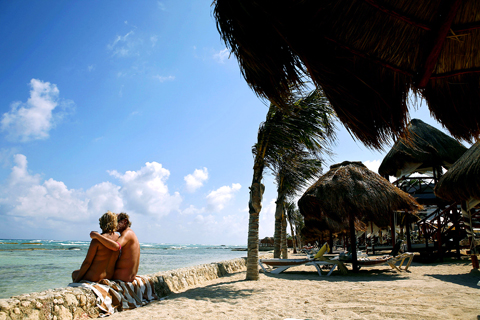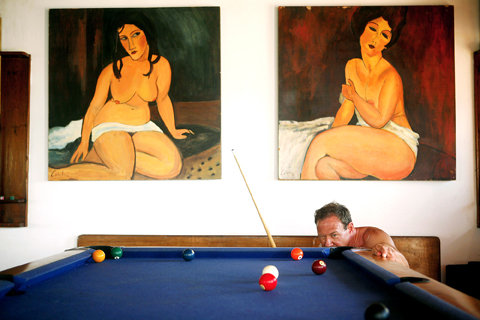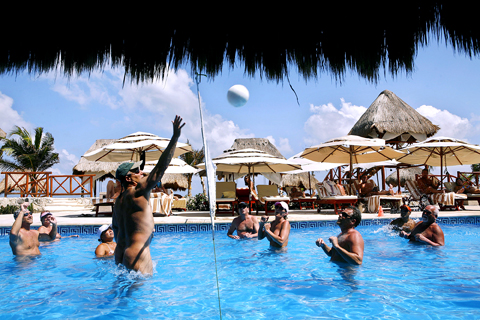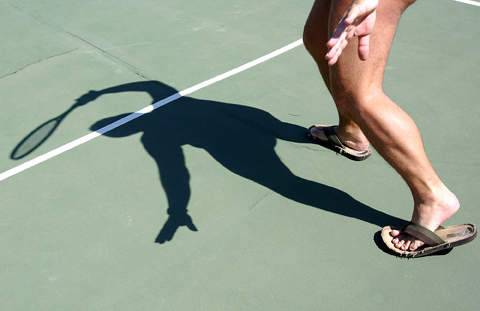When Larry Massa says he likes to travel light, he means it. No need for a jacket and tie at dinner, a pristine set of tennis whites when he hits the court or even a bathrobe to wear when heading from his hotel room to the pool or the spa.
For when Massa, 74, a retired Navy commander and computer science engineer from Virginia Beach, Virginia, and his wife, Darlene, go on vacation, they do it in the nude. “If you haven’t tried it, there’s no way I can tell you what a fun thing it is, what an added dimension to a vacation it can be,” said Larry Massa, who has been taking “clothing-optional” vacations since 2001 and whose most recent trip was to an all-nude resort in Mexico. “I’ll never forget the day,” said Massa, recalling the couple’s first nudist vacation at a Caribbean resort. “The place was full. We went to the far end of the pool and Dar said, ‘I’m going to take my top off.’ I thought I’m not going to wear these stupid swim trunks in the pool. So I jumped in naked. She looked down at me and dropped her bottoms and we never looked back.”
To many, the mention of a nudist resort conjures up images of isolated beach colonies with volleyball courts, hippie-style gatherings in a secluded campground or RV parks tucked away in the woods for vacationers who still talk reverently about the Summer of Love.

PHOTOS: NY TIMES NEWS SERVICE
And while those kinds of offerings still exist for Massa and his fellow naturalists, as they prefer to be called, the real boom in nude vacations is coming at the high end of the business, as upscale hotels and resorts, and even some luxury cruise lines, have begun to see the economic potential in the no-clothes crowd — particularly those who want to shed their clothes but not their pampered lifestyles.
The US$300-a-person all-inclusive Hidden Beach Resort, a nude-only luxury hotel that opened in 2003 along Mexico’s popular Mayan Riviera, greets guests with champagne upon arrival. Rose petals are tossed on the beds at turndown, and beach butlers hand out towels and reading materials to guests relaxing in the nude, while they themselves walk around in discreet uniforms of buttoned-down shirts and khaki pants.
Sea Mountain Inn, a two-year-old nude resort and spa in Desert Hot Springs, California, with room rates ranging from US$269 to US$900 a night, features Asian-influenced rooms with Egyptian bed linens, flat-screen TVs and natural mineral water pumped into the shower. The upscale Occidental Grand Fuerteventura in the Canary Islands has set aside entire blocks of rooms exclusively for nude guests. And several mainstream hotels, including Caesar’s Palace and the Mirage in Las Vegas, have introduced topless pools in the past couple of years.

PHOTOS: NY TIMES NEWS SERVICE
Even in the vacation home market, a new clothing-optional condo-resort, Mira Vista in Marana, Arizona, is selling more than a hundred two-bedroom condominiums, priced from US$244,500.
Last year, nude recreation represented a US$440 million industry — up from US$400 million in 2001 and US$200 million in 1992 — and it’s still growing, says the American Association for Nude Recreation, which promotes au natural vacations as “nakations.” According to the association, roughly 20 percent of members have a median household income of US$106,000, drive luxury cars and spend US$3,000 or more on travel.
The types of nude vacations have expanded too. Vacationers can now roll out a mat at all-nude yoga retreats, share banana bread with other guests at all-nude bed-and-breakfasts, gear up for nude mountain biking in California’s High Desert and saunter around the decks of cruise ships chartered specifically for clothing-free travel. In Germany, a travel operator has arranged for an all-nude charter flight this summer to take customers to a clothing-optional retreat in the Baltics. The naturalists will take off and land fully clothed, but shed their clothes once airborne. (Flight attendants and crew will, however, keep their uniforms on.)

PHOTOS: NY TIMES NEWS SERVICE
SpaFinder.com, an online spa search engine, recently created a separate category for “nudist spa vacations” after noticing an increase in searches for the term. Since November, searches on SpaFinder.com for such trips have averaged about 720 a month — beating out “pet-friendly spas” (284) and “waxing services” (298).
“It’s no longer just a grass-roots, nuts-and-sweets kind of thing,” said Nancy Tiemann, president of Bare Necessities, which specializes in nude travel and is offering a seven-day Greek cruise in September, along with four others this year and next. Four months ago, Teimann’s company began selling an all-nude 2010 Hawaiian cruise on Celebrity Cruise Line’s Constellation, a 2,000-passenger ship. Already, about 90 percent of the ship is booked.
When the company, which she owns with her husband, Tom, began chartering small ships for all-nude cruises in the early 90s, she said many mainstream cruise operators dismissed them as a joke. “Now,” Tiemann said, with perhaps a touch of hyperbole, “they’re trampling each other to get our business.”

PHOTO: NY TIMES NEWS SERVICE
Most nude vacationers say that what they enjoy most is liberation from the typical pretenses of society. “When you don’t have any clothes on, you don’t know if someone’s a judge or a doctor, or a lawyer or a mechanic,” said Larry Massa. “You are what you are.”
But no matter how popular and upscale nude resorts become, one social convention is unlikely to change: Nudity and family vacations don’t always mix.
Just ask the Massas. They simply can’t convince their children, all in their late 40s, to join them on their two or three trips a year.
On vacation at the Couples Negril resort in Jamaica, which has a nude beach in addition to what she refers to as a “prude” beach, Darlene Massa said she casually mentioned to her son and daughter-in-law that she was going to check out the nude side.
“Mom,” replied her son, “I don’t want to see you naked.”

Nov. 11 to Nov. 17 People may call Taipei a “living hell for pedestrians,” but back in the 1960s and 1970s, citizens were even discouraged from crossing major roads on foot. And there weren’t crosswalks or pedestrian signals at busy intersections. A 1978 editorial in the China Times (中國時報) reflected the government’s car-centric attitude: “Pedestrians too often risk their lives to compete with vehicles over road use instead of using an overpass. If they get hit by a car, who can they blame?” Taipei’s car traffic was growing exponentially during the 1960s, and along with it the frequency of accidents. The policy

Hourglass-shaped sex toys casually glide along a conveyor belt through an airy new store in Tokyo, the latest attempt by Japanese manufacturer Tenga to sell adult products without the shame that is often attached. At first glance it’s not even obvious that the sleek, colorful products on display are Japan’s favorite sex toys for men, but the store has drawn a stream of couples and tourists since opening this year. “Its openness surprised me,” said customer Masafumi Kawasaki, 45, “and made me a bit embarrassed that I’d had a ‘naughty’ image” of the company. I might have thought this was some kind

What first caught my eye when I entered the 921 Earthquake Museum was a yellow band running at an angle across the floor toward a pile of exposed soil. This marks the line where, in the early morning hours of Sept. 21, 1999, a massive magnitude 7.3 earthquake raised the earth over two meters along one side of the Chelungpu Fault (車籠埔斷層). The museum’s first gallery, named after this fault, takes visitors on a journey along its length, from the spot right in front of them, where the uplift is visible in the exposed soil, all the way to the farthest

The room glows vibrant pink, the floor flooded with hundreds of tiny pink marbles. As I approach the two chairs and a plush baroque sofa of matching fuchsia, what at first appears to be a scene of domestic bliss reveals itself to be anything but as gnarled metal nails and sharp spikes protrude from the cushions. An eerie cutout of a woman recoils into the armrest. This mixed-media installation captures generations of female anguish in Yun Suknam’s native South Korea, reflecting her observations and lived experience of the subjugated and serviceable housewife. The marbles are the mother’s sweat and tears,